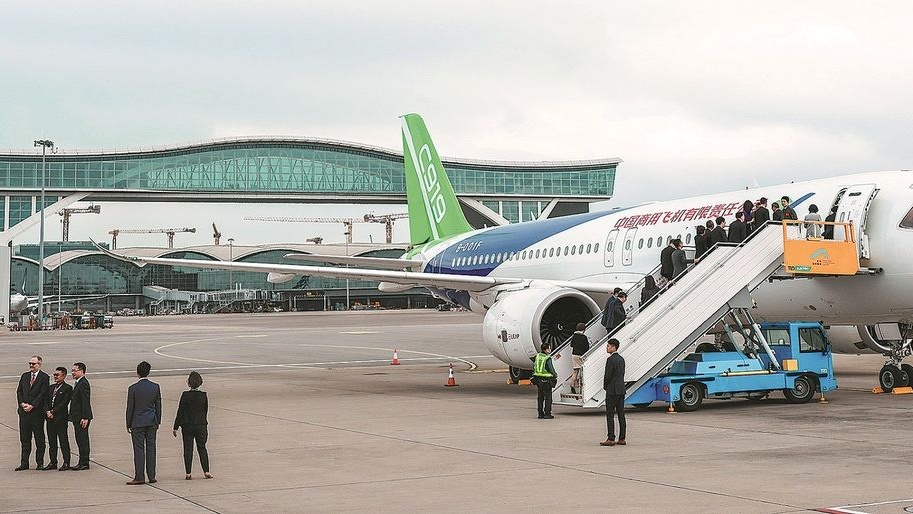source: editor:Zhang Wenni
 、
、
Guests board a C919 airplane to tour its interior at Hong Kong International Airport on Dec 13, 2023. [Photo by Andy Chong/China Daily]
Last month, the Chinese mainland's domestically built C919 civilian passenger jet and its older, smaller cousin, the ARJ21, made their first visits to Hong Kong. The occasion included a demonstration flight over the city and Victoria Harbour, as well as both planes being available for viewing on the tarmac at Hong Kong International Airport.
It was a welcome sight, but why were they there? Perhaps it was because the airport was recently voted "Asia's Leading Airport 2023", after the same accolade was given in 2020 and 2021, as well as "China's Leading Airport 2023".
John Lee Ka-chiu, chief executive of the Hong Kong Special Administrative Region, lauded the visit and what it represented for Chinese commercial aviation. Both aircraft will not only feature heavily in the domestic market but will also seek wider exposure and customers farther afield.
Hong Kong is a major transportation hub for passengers as well as freight, but the plane types used are themselves a key factor. It's a tough market, with established companies with deep pockets currently ruling the skies. It's not quite a duopoly, but it's close.
Indeed, the mid- to wide-body and long-distance passenger and freight jet markets are currently wholly dominated by the United States-based company Boeing and the European consortium Airbus. Only minimal parts are played by COMAC(China), Bombardier (Canada) and Embraer (Brazil), rounded out by Irkut in Russia.
However, this is likely to change, at least for single-aisle aircraft with a range of up to 5,000 kilometers.
Of the smaller players, COMAC has the potential to compete in this zone. And not just against Bombardier, which now specializes in smaller jets for the private business market, and Embraer with its E series of jets, but also against aircraft like the Boeing 737 and Airbus A220 and A320.
The ARJ21 and its variants could pitch such a case at the smaller end, and it was pushed out to the international market only in 2022, though it began domestic operations on the Chinese mainland in 2016. External success will likely depend not just on price but also fuel efficiency, technical support and service needs, maintenance costs, reliability and durability.
A decent, existing domestic customer base among more than a dozen Chinese commercial passenger companies and a track record of thousands of trouble-free flights underpin the operation and model confidence in the future.
Indeed, China, Europe and North America are the world's top three passenger travel markets. It is predicted that China alone will account for about 20 percent of the global airplane demand by 2042.Chinese commercial passenger companies are expected to order more than 8,500 new jets by then. Most orders will be for plane types with single aisles, such as the ARJ21 and larger C919. Expansion to Southeast Asia is a plausible target, with the Indonesian company TransNusa being the first serious international operator of the ARJ21 aircraft, so things look to be picking up.
Furthermore, besides having domestically produced commercial jetliner capacity with the ARJ21, the newer C919 is the new kid on the block. It can accommodate 160 to 190 passengers with a range of 4,000 to 5,500 km, so it can cover the whole of China. As such, this is now realistic domestic competition for Boeing and Airbus, at least in this range and passenger number. China has also developed its own high-performance jet engine through Aero Engineer Corp of China in Shanghai, removing dependence on Western-supplied engines. This is a crucial development.
China can innovate and perform at the highest aviation technology levels, as it has already demonstrated in the space sector. The industry desperately needs this for future aviation viability in a net-zero carbon future.
Hydrogen-electric aircraft, for example, may still be several decades away, especially for anything other than short-haul destinations. In the medium term, many companies seek sustainable aviation fuels from renewable materials to improve their green credentials. But perhaps China can achieve breakthroughs that make large hydrogen-electric planes viable.
The author is a professor on the faculty of science at the University of Hong Kong and the director of its Laboratory for Space Research.